20 Different Types of Dogwood Trees

Dogwoods, which are a type of woody plant found in the Cornaceae family, are also a member of the cornus genus. Most types of Dogwood Trees are distinguished by unique bark, berries, and blossoms. The various types of Dogwood Trees may be deciduous (lose their leaves) trees or even shrubs. However, some of these dogwood varieties are evergreen.
Dogwood Trees produce drupes – a.k.a. stone fruit, that has either one or two seeds. The fruit is often bright and colorful. The drupes from the variety of cornus trees and shrubs are considered edible, although many are nearly flavorless. These fruit/drupes have been shown to help fight the flu and typical winter colds because they contain high amounts of Vitamin C. The dense, finely-grained wood is valued for many special purposes, like cutting boards. The following offers a look into 20 types of Dogwood trees.

1. The Siberian Dogwood is a tough but beautifully graceful tree.
The Siberian Dogwood (Cornus alba), which may be known as the Red-barked Dogwood, is native to the continent of Asia. This type of dogwood is one of the faster-growing types of Dogwood trees. This multi-stemmed variety is actually a large-sized deciduous shrub, so it can often be used as a focal point of any landscape. The Siberian Dogwood grows in an upright fashion, offering color year-round. Butterflies and pollinators are attracted to the small spring flowers. In mid-summer, the Siberian provides berries, which, when ripe, are a treat to local birds. Its red stems are in striking contrast, to the winter scene, especially on snowy days

2. The Roughleaf Dogwood naturally attracts butterflies and other types of pollinating insects.
The Toughleaf Dogwood (Cornus drummondii), also known as the Rough-leaf Dogwood or Drummond’s Dogwood, is a deciduous tree found across the North American Midwest and plains. These types of Dogwood trees also grow in regions surrounding the Mississippi River. Found along the borders of forest (and now planted to buffer the edges of highways, decks, and parking lots), the dogwood can grow to 15 to 25 feet and offers dense protection for wildlife and fine food for more than 40 types of birds.
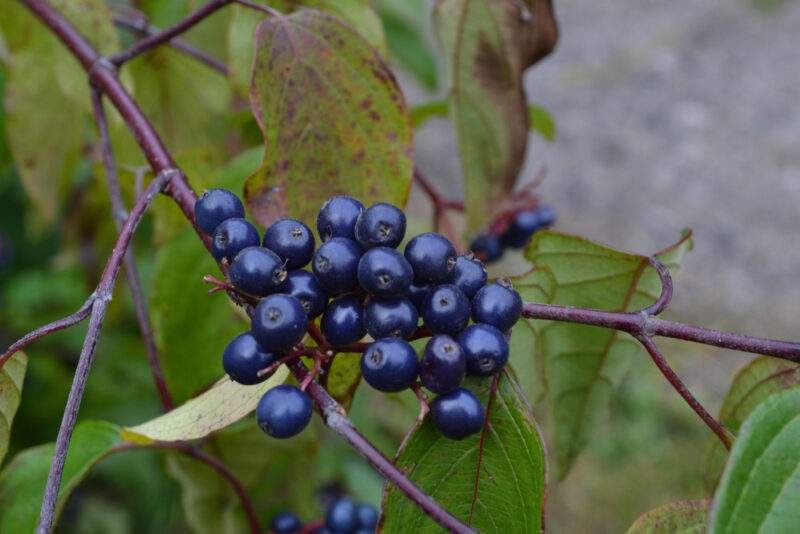
3. The Silky Dogwood is a great plant that offers four-season foliage.
The Silky Dogwood (Cornus amomum) grows in lowland locations that offer great moisture, like swamp borders, stream/pond edges, and floodplains. They are medium-sized deciduous shrubs that grow in North America – as far north as New Foundland to Florida. They grow to about 12 feet and bloom from May to June, needing a medium amount of maintenance. The Silky Dogwood, which helps deter deer and erosion, prefers full sun, with part shade, and produces showy fruit that birds love.
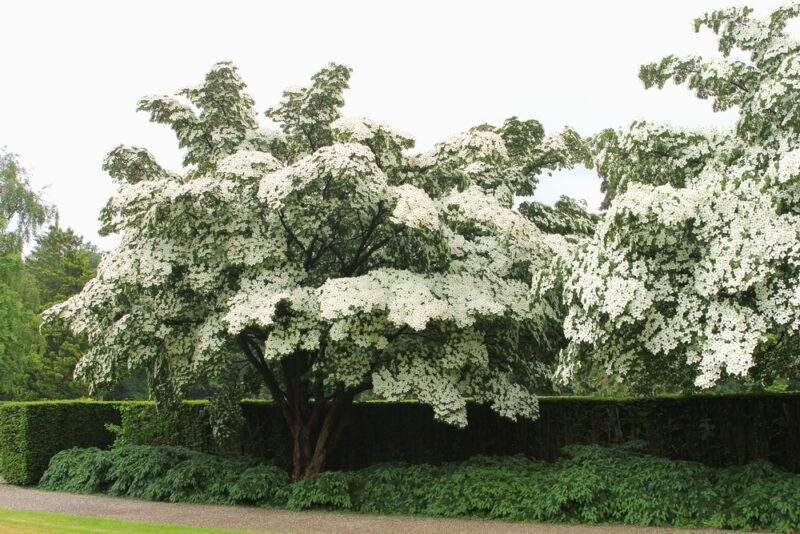
4. The Kousa Dogwood is an ornamental flowering tree that offers gorgeous spring flowers.
The Kousa Dogwood (Cornus kousa), which is also known as the Japanese Dogwood, is often sold as one of the edible types of Dogwood trees. The tree, while maintaining its delicate beauty, is actually a rough and tough dogwood variety. These dogwoods make a visual splash in all four seasons, with winter highlighting the unusual bar that looks like a jigsaw puzzle. The Kousa Dogwood can grow to heights of 25 feet and spread an equal distance. It can grow one to two feet per year.
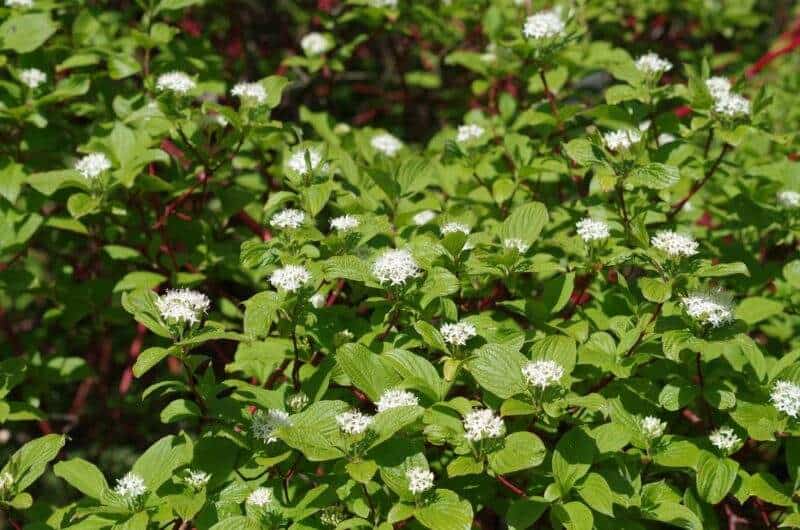
5. The Brown Twig Dogwood typically grows next to or even within a stream
The Brown Twig Dogwood (Cornus glabrata), which is native to the states of Oregon and California, grows in the Sierra foothills, the Channel Islands, and coastal regions but typically below 4,000 feet. The bark can be purple, red, or brown, which makes for an interesting contrast in winter when flowerless. The Brown Twig Dogwood’s leaves are bright green before turning red when autumn arrives. This deciduous type of Dogwood Tree grows to 20 feet in a fast, weeping manner.
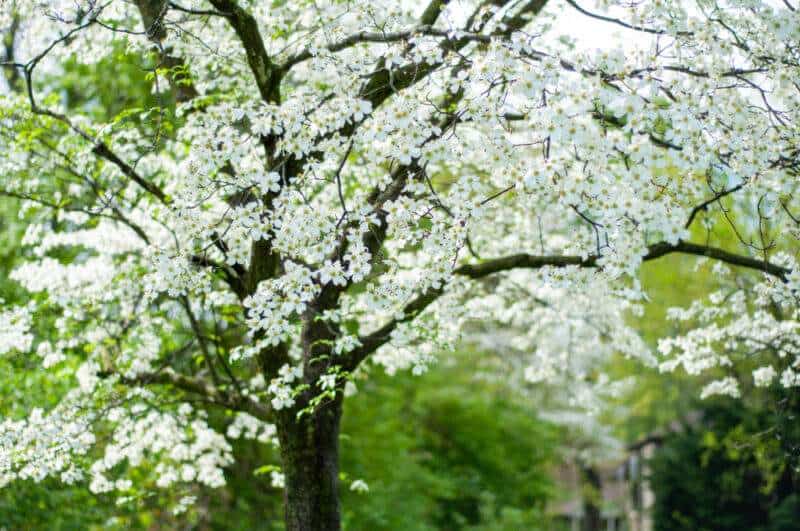
6. The Bretschneider’s Dogwood is a larger flowering deciduous shrub.
The Bretschneider’s Dogwood (Cornus bretschneidieri) was first described in 1899. The Bretschneiger’s Dogwood is a deciduous tree that can grow to approximately 18 feet. This is one of the types of Dogwood Trees that are native to the northern areas of China. These dogwoods prefer a sunny spot that has a bit of shade with soil that stays moderately moist. Its leaves are oval and grow oppositely. But note they can tolerate frost.

7. The Koehne’s Dogwood grows in mixed forests that are situated in valleys or on sloping areas.
The Koehne’s Dogwood (Cornus koehneana) is a type of medium-sized deciduous tree that can grow to about 30 feet in height. Its pinnate leaves have a narrow elliptical shape and grow in a pattern that resembles a fern. Its fragrant white flowers are about an inch in size and are followed in autumn by waxy berries that are preferred by many types of wildlife. This perennial offers unusual color in the fall and offers showy flowers. This type of dogwood has won the preeminent Awards of Garden Merit.

8. The Large-leafed Dogwood is tolerant to various types of soil.
The Large-leafed Dogwood (Cornus macrophylila) is a deciduous shrub/tree that can grow to heights of 40 feet (and widths of 30 feet). Its white flowers show up in Spring and attract birds and other wildlife. This type of dogwood grows with regular water in the sun and partial shade. The Large-leafed Dogwood Tree is a multi-stemmed tree that offers large leaves, clusters of white blooms during the summer (July to August), and followed by drupes that are bluish-black when mature.
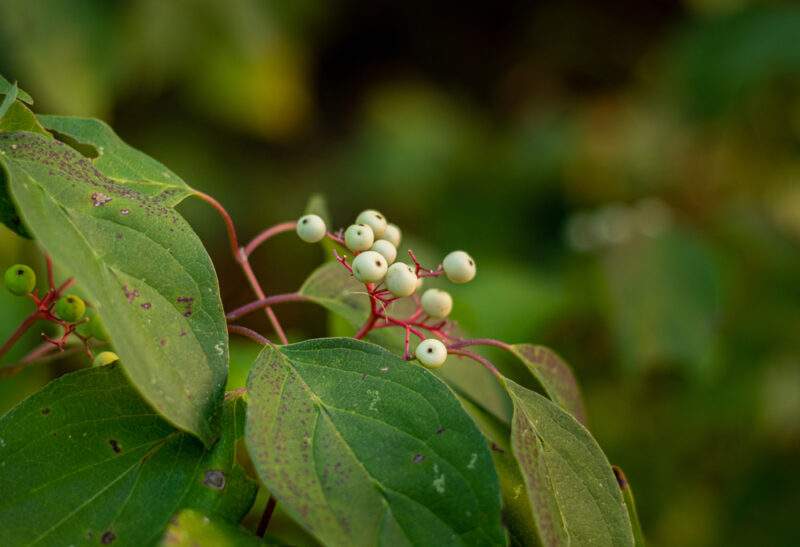
9. The Northern Swamp Dogwood is one of the larger types of Dogwood trees.
The Northern Swamp Dogwood ((Cornus foemina) is a perennial deciduous shrub that can grow to approximately 25 feet. This type of dogwood blooms from March to June with beautiful white flowers. The Northern Swamp Dogwood is native across the Midwest (as far west as Texas) and the eastern United States, preferring uplands and swamps. These dogwoods like part shade but require wet moisture.
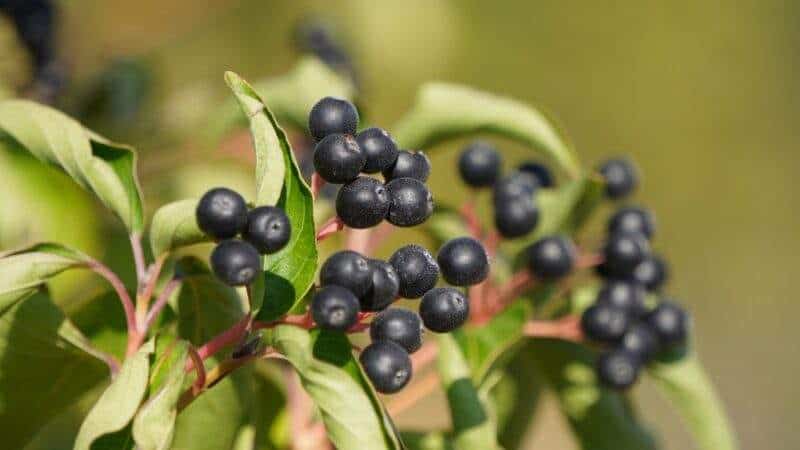
10. The Common Dogwood is a type of tree that is frost-hardy.
The Common Dogwood (Cornus sanguinea), which is also known as the Blood-twigged Dogwood, the European Dogwood, or the Dogberry, is native to the continents of Asia and Europe. This type of deciduous dogwood prefers full sun and medium moisture but will tolerate shade and attract both birds and butterflies. The showy flowers bloom in May and June. Its leaves are broad and elliptical and grow up to 4 inches. Pruning is not required, and the Common Dogwood helps with natural erosion.
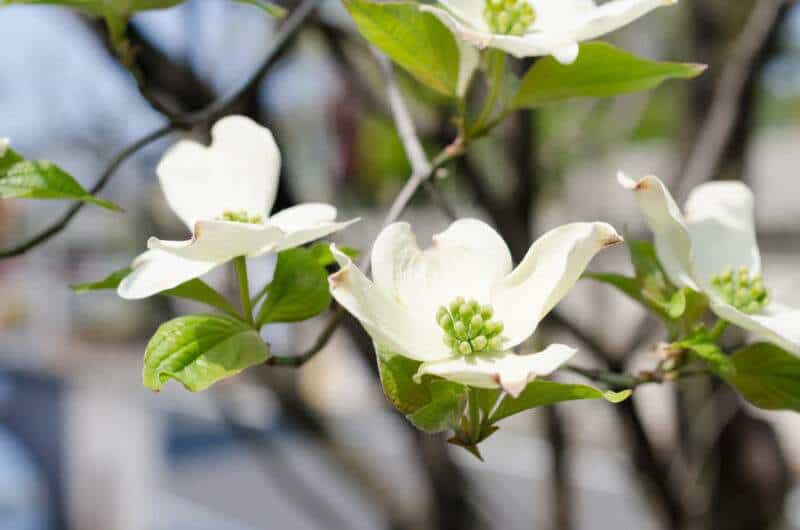
11. Walter’s Dogwood is a tree that is native to areas of eastern Asia.
Walter’s Dogwood (Cornus walteri) s one of the types of deciduous dogwood trees that grows upwards of 30 to 40 feet in height. Its bark resembles the skin of an alligator, especially on older Walter’s Dogwood trees. While not native to North America, it can be grown throughout the country in USDA hardiness zones 55a through 8a. This dogwood offers great shade with white and creamy flowers. The fruit is small and fleshing and attracts birds.
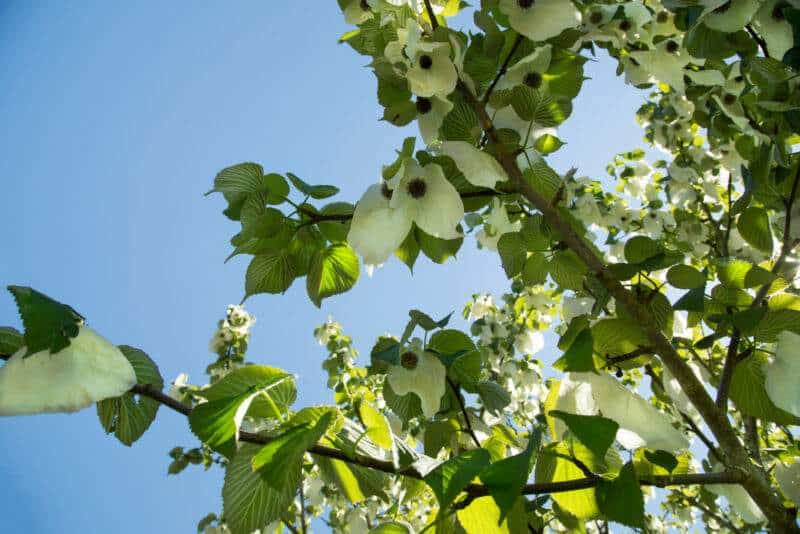
12. The Ghost Dogwood grows best in acidic soil, with a root system covered by organic mulch.
The Ghost Dogwood (Cornus wilsoniana), which is known as Wilson’s Dogwood, is native to Southern China’s forest and wooded areas. This tree is typically grown as an ornamental tree that blooms in small white clusters of flowers in the late part of spring. Plant the Ghost Dogwood in full sun that has some shade but keep the soil moist and well-drained for the best results, which typically max out at 15-16 feet.
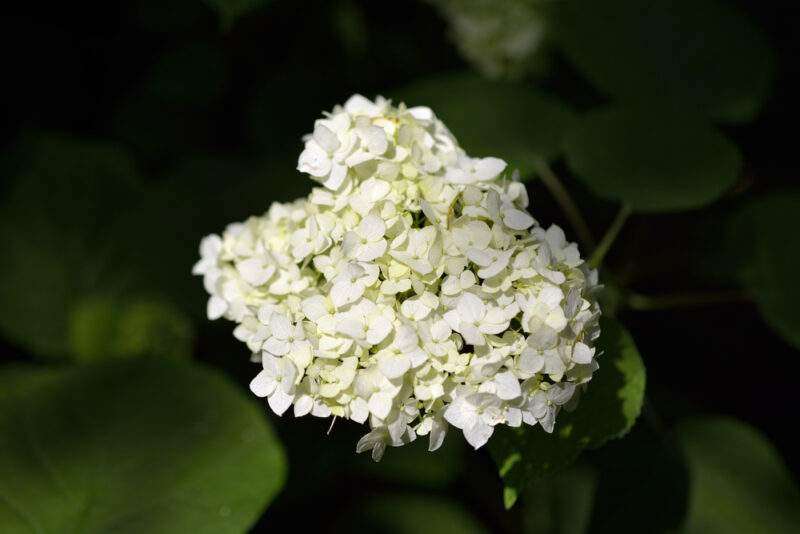
13. The Round-leaf Dogwood is a perennial tree that is native to the northeastern U.S. and southeastern Canada.
The Round-leaf Dogwood (Cornus rugosa) is native to several central and eastern U.S. states, plus the southern reaches of Canada. The white flowers of the Round-leaf Dogwood bloom in early summer, with the fruit eaten by several types of grouse. These types of dogwood trees prefer soil that is well-drained and naturally with an average amount of moisture. The fruit of the Round-leaf Dogwood matures in October.

14. Helmsley’s Dogwood is a deciduous upright tree that is native to China.
Helmsley’s Dogwood (Cornus Hemsley), which is known by a number of alternative names, is a tall type of dogwood tree that is native to Japan. This dogwood can grow to heights that reach 60 feet and produces pale-yellow to white flowers in the Summer. This type of dogwood will spread to up to 12 feet in five to ten years if grown in either full sun or partial sun with well-drained but moist soil.

15. The Canadian Dwarf Dogwood blooms from May to September.
The Canadian Dwarf Dogwood (Cornus canadensis), which is also known as the Bunchberry, is native to Eastern Asia, the Northern parts of North America as well as Greenland. The Eurasion Dwarf dogwood grows to less than that foot, with white blooms from May to July. This low-maintenance dogwood tolerates deer and rabbits and attracts both butterflies and birds. Part shade in medium moist soil that is well-drained in the best place to grow the Canadian Dwarf Dogwood.
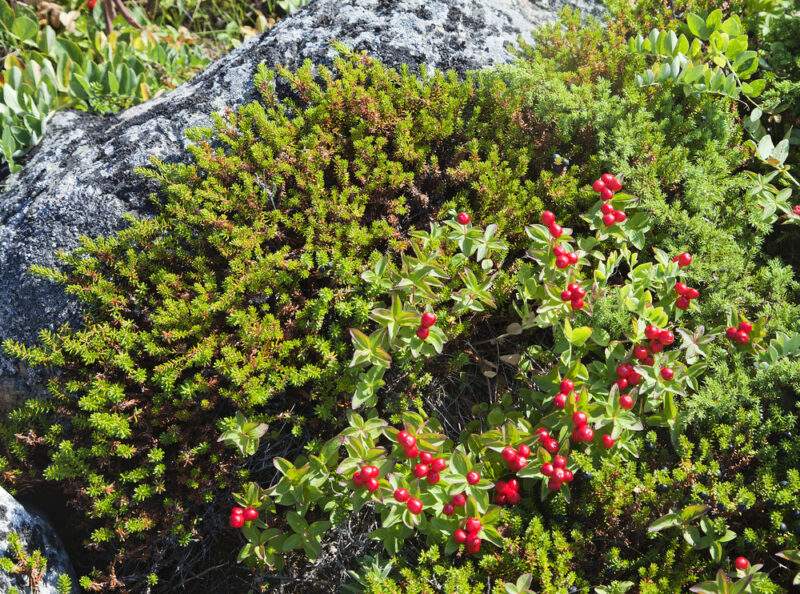
16. The Eurasian Dwarf Cornel Dogwood will be found growing on the shores of lakes, shrubby thickets, swamps, bogs, and river banks.
The Eurasian Dwarf Cornel Dogwood (Cornus suecica) is typically found in subarctic and arctic regions of North America and Europe, extending as far east as part of Russia and Japan. This type of low-growing perennial dogwood is grown for food (rich in pectin), medicine, and even as ornamental ground cover. Both flies and bees are attracted to this dogwood as a pollinator.
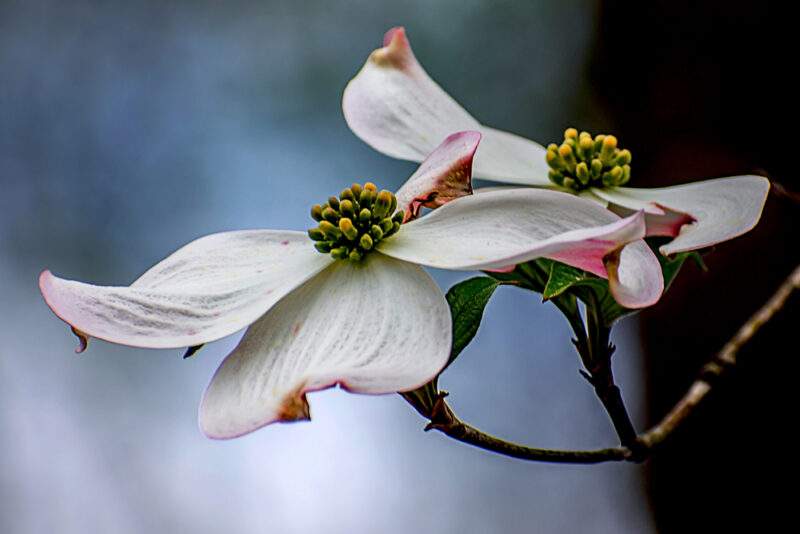
17. The Flowering Dogwood is a flowering tree that grows to 40 feet in ideal conditions.
The Flowering Dogwood (Cornus florida), which is also known as the Virginia Dogwood or the American Boxwood, can grow to heights and widths of 30 feet. It’s one of the types of dogwood trees that offer four seasons of interest. This dogwood prefers part shade that grows in moist, fertile soil. These trees are native from Southern Canada/Maine to south Florida, Texas, and Mexico, among others.
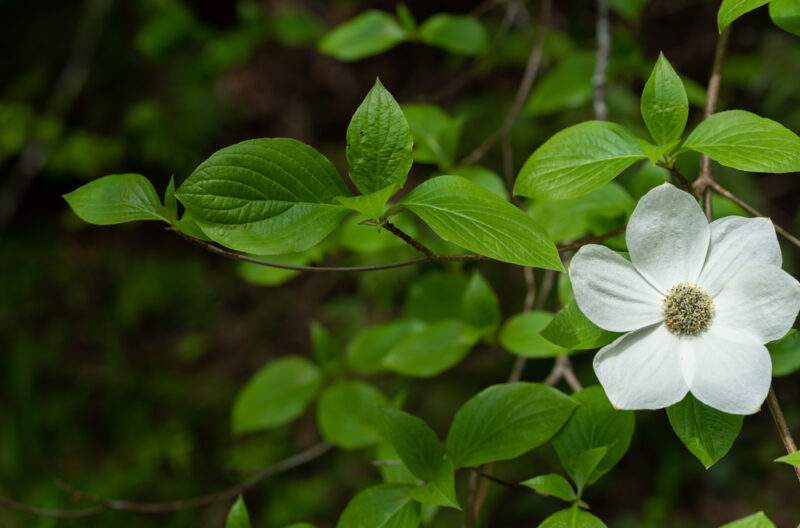
18. The Pacific Dogwood is native to southern British Columbia and western North America.
The Pacific Dogwood (Cornus nuttallii) is a type of dogwood that grows to 40 feet in height. It blooms in two seasons – spring and, at times, fall. The tree grows in USDA hardiness zone 7 in well-drained soils that tend to be acidic and high in organic material. It is also intolerant to the hot sun, as that damages its bark.
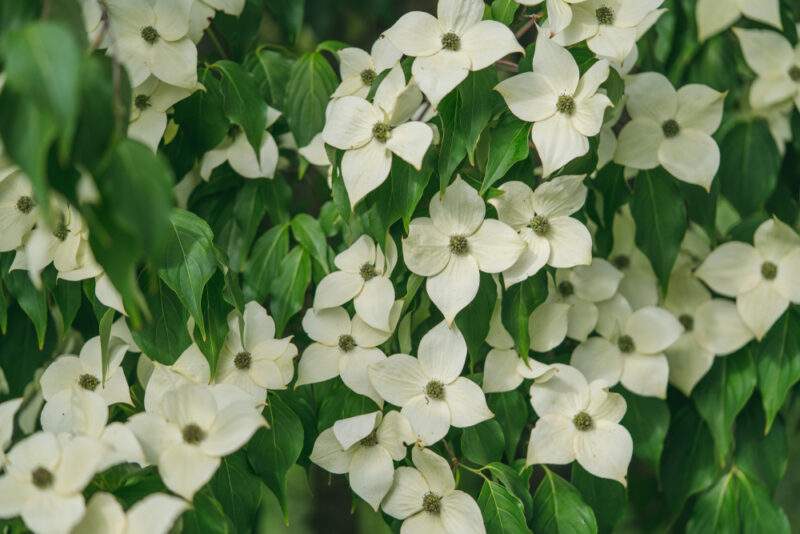
19. The Himalayan Flowering Dogwood is a type of evergreen that has small flowers.
The Himalayan Flowering Dogwood (Cornus capitata), which is also known as Bentham’s Cornel or Headed-flowered dogwood, offers four seasons of interest. This type of dogwood is loved for its beautiful flowers and bright fruit. This dogwood can grow to 40 feet and spread up to 30 feet in width. The Himalayan Flowering Dogwood tolerates deer and attracts birds, so it can be used in garden borders, garden beds, and meadows because it is easily grown in medium moisture, organically rich, well-drained soils.

20. The Hong Kong Dogwood is a type of evergreen that is native to Laos, China, and Vietnam.
The Hong King Dogwood (Cornus hongkongensis) These dogwoods grow to heights that exceed 15 feet. This dogwood produces fragrant white flowers that blossom in late spring into the early parts of early summer. Its leaves which are green, turn purple and red when fall arrives. This type of dogwood prefers a moist spot that is sunny but also sheltered from the wind. It is noted that the Hong Kong Dogwood is frost-hardy as well.
You can also read:






